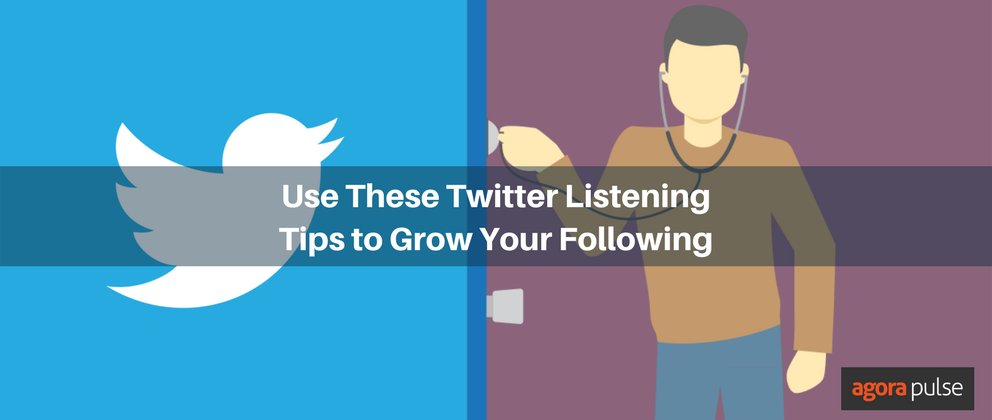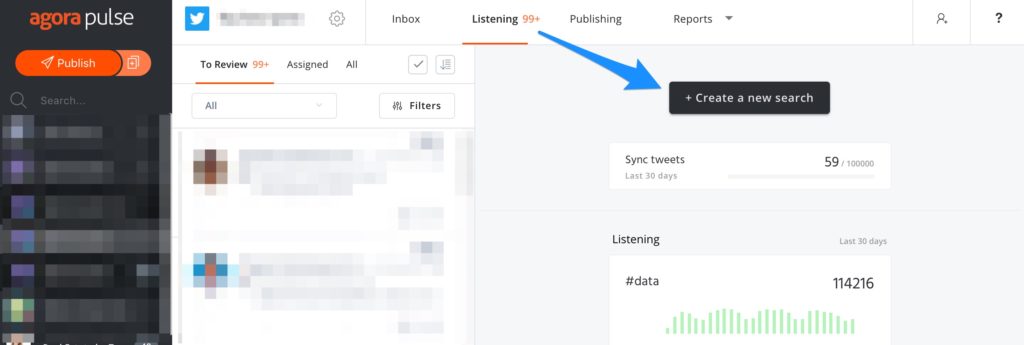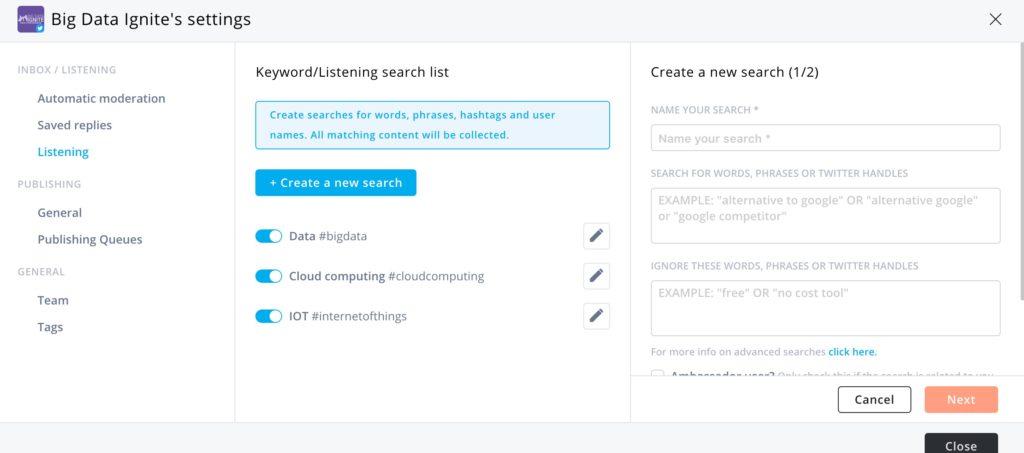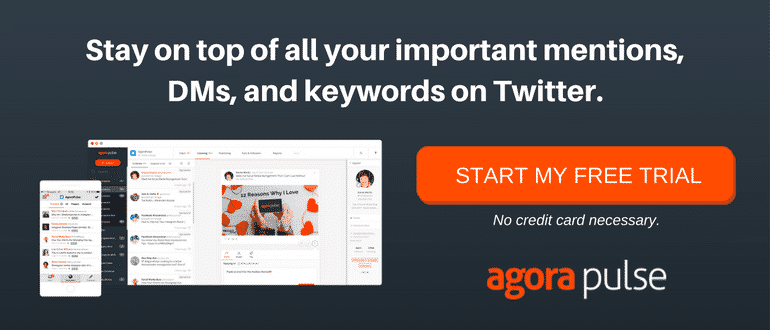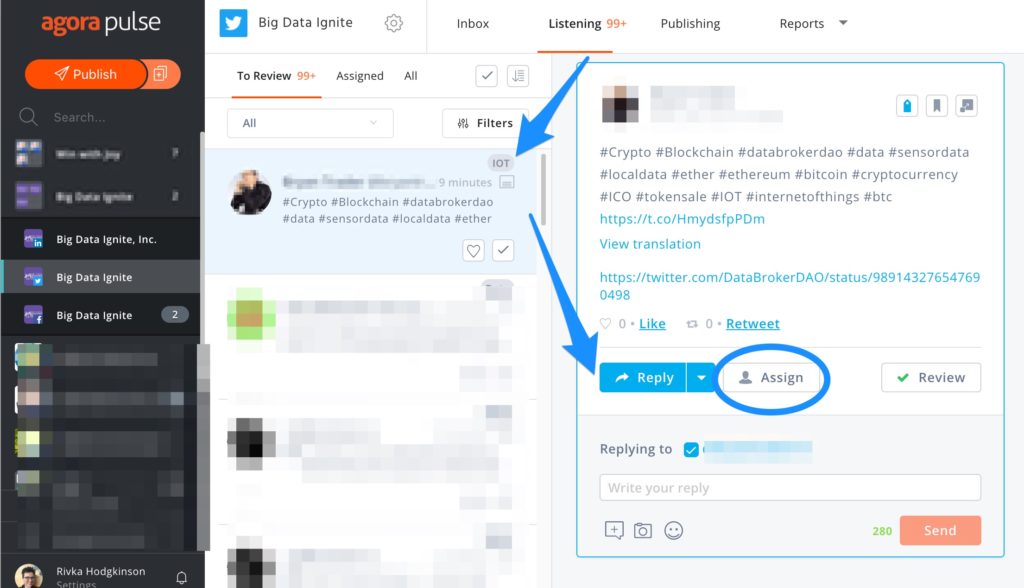The right Twitter listening tips can help you grow your Twitter following right away.
That’s why I’d love to share my favorites, developed from running dozens of Twitter accounts for various brands. These simple tips can be implemented in as little as a few minutes a day and, if you are an agency, you can easily integrate them with your team workflow.
What is Twitter Listening?
Twitter Listening is a tool within Agorapulse that brings all your Twitter searches into one easy to read inbox you can interact with. While you can use the strategies I’ll share with the Twitter search on Twitter itself, using Agorapulse will save you a ton of time.
With the Agorapulse listening tool, you don’t have to save and repeat your searches and you can see the impact of listening on your goals directly in the reports. That’s why this is a tool I recommend to any of my clients looking to build a Twitter following this way.
But why does it work? Increasing your Twitter interactions makes your profile more visible. It helps you connect with people who are actively looking to buy your products and services and helps build a deeper connection with your existing customers. It can even help you keep tabs on your competitors.
To get started, go to your Agorapulse dashboard and click on “Listening.” Here you’ll be able to create searches. But what should you search for? Here are some tips to get you started with this powerful tool.
Tip 1: Listen for Your Brand
The first and most basic type of Twitter listening to set up is to listen for your own name and/or brand. While people who use your Twitter handle will show up in your mentions, it’s possible that there is social media chatter going on that you are missing. Users may only mention your website, your name and not your Twitter handle, or mention something else altogether.
Think through what different terms people may be using when they are talking about you and set up a search for each one.
This can help you better understand the full reach of your brand on Twitter when you create your reports. Hopefully, these people are singing your praises. However, even if they are dishing out criticism, listening helps you hear it and allows you to respond productively.
Tip 2: Listen for Your Keywords
What are your ideal clients or customers looking for on Twitter? Are you keeping track of the buzz around those things?
The key to setting up keyword listening is to really understand what your clients or customers are looking for and get a good handle on the language they use.
In the example above, the client is a tech conference. Their areas of focus include big data, internet of things, and cloud computing. I created hashtag based searches for all three of these topics. It would probably be good to add more for some of the alternative common hashtags. For example, internet of things is often abbreviated as IoT.
Another example might be a car sales company. If they use the search #newcar they will get some people looking for a new car, but will also hear a lot of people who just bought one and are showing it off. Entering keywords related to car repair, breakdown, or trade-ins might make more sense and yield relevant results.
What are the frustrations your clients have that lead up to buying from you? Include those keywords in your searches. Better yet, when you respond, don’t pitch your product or service. Instead, use the listening opportunity to add a tip or helpful piece of advice, so you can start building your relationship and open the door for next time they are in the market.
Tip 3: Listen for Your Competitors
This tip works especially well if you are a lesser known brand. Many people say “Jello” when they mean gelatin or “Kleenex” when they mean facial tissues because of brand recognition.
Use this to your advantage by creating searches for your top competitors. This will allow you to interact with people discussing their products, as well as see what their social media strategies are in real time.
Be careful with your responses on this one. Be sure that you have clear direction about how aggressively to pursue this audience if you are not the primary decision maker in the business.
How to Be a Better Listener
As you integrate listening into your social media strategies, go ahead and start using some advanced search tips too. This can help you narrow down your results to things that are really useful by eliminating irrelevant searches.
You also want to make sure that you are working with your team (if applicable.) Another great feature of Agorapulse is that you can assign any post to a teammate if it’s a question that you don’t know the answer to, or is better handled by another coworker.
Finally, remember that in order to get more followers, you have to be interesting and engaging. This is what will make people want to follow you in the first place. Take some time to review your Twitter bio, and see if it can be more compelling. Don’t just like posts– take the time to reply with a helpful comment.
Remember that this is another tool to find people who may be a great fit for your product or service. It’s your job to take the first step and say hello. If you do a good job, then you’ll start getting more followers almost immediately. And with a bit of effort, those followers will get to know you and turn into customers.
What are your favorite Twitter listening tips? Send us a tweet, and let us know.
